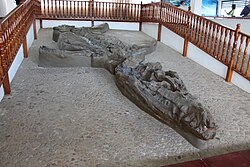Kronosaurus
|
Kronosaurus Temporal range: Early Cretaceous, 125–99 Ma |
|
|---|---|
 |
|
| K. boyacensis in Villa de Leyva, Boyaca, Colombia | |
| Scientific classification | |
| Kingdom: | Animalia |
| Phylum: | Chordata |
| Class: | Reptilia |
| Superorder: | †Sauropterygia |
| Order: | †Plesiosauria |
| Family: | †Pliosauridae |
| Subfamily: | †Brachaucheninae |
| Genus: |
†Kronosaurus Longman, 1924 |
| Species | |
|
|
Kronosaurus (/ˌkrɒnoʊˈsɔːrəs/ KRON-o-SAWR-əs; meaning "lizard of Kronos") is an extinct genus of short-necked pliosaur. With an estimated length of 9-10.5 m, it was among the largest pliosaurs, and is named after the leader of the Greek Titans, Cronus. It lived in the Early Cretaceous Period (Aptian-Albian). Fossil material has been recovered from Queensland in Australia, and Colombia, and assigned to two species.
Like other pliosaurs, Kronosaurus was a marine reptile. It had an elongated head, a short neck, a stiff body propelled by four flippers, and a relatively short tail. The posterior flippers were larger than the anterior. Kronosaurus was carnivorous, and had many long, sharp, conical teeth. A feature of the genus Kronosaurus is the first three maxillary teeth are enlarged to fangs. Current estimates put Kronosaurus at around 9–10.5 meters (30–34 feet) in length. In 2009, K. queenslandicus was estimated to weigh up to 11,000 kilograms (11 metric tons).
All Sauropterygians had a modified pectoral girdle that supported a powerful swimming stroke.Kronosaurus and other plesiosaurs/pliosaurs had a similarly adapted pelvic girdle, allowing them to push hard against the water with all four flippers. Between its two limb girdles was a massive mesh of gastralia (belly ribs) that provided additional strength and support. The strength of the limb girdles, combined with evidence of large, powerful swimming muscles, indicates that Kronosaurus was likely a fast, active swimmer.
...
Wikipedia
